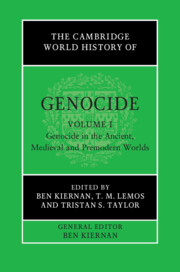Book contents
- The Cambridge World History of Genocide
- The Cambridge World History of Genocide
- The Cambridge World History of Genocide
- Copyright page
- Contents
- Figures
- Maps
- Tables
- Contributors to Volume I
- General Editor’s Acknowledgements
- General Editor’s Introduction to the Series
- Introduction to Volume I
- Part I Themes of Genocide through History
- Part II The Ancient World
- Part III The Medieval World and Early Imperial Expansions
- 15 William the Conqueror’s Harrying of the North, 1069–1070
- 16 Genocidal Massacres of Jews in Medieval Western Europe, 1096–1392
- 17 Crusaders and Mass Killing at Jerusalem in 1099
- 18 The Albigensian Crusade and the Early Inquisitions into Heretical Depravity, 1208–1246
- 19 Mongol Genocides of the Thirteenth Century
- 20 Việt Nam and the Genocide of Champa, 1470–1509
- 21 Genocidal Massacres in Medieval India
- 22 Mass Extermination in Prehistoric Andean South America
- 23 The Spanish Destruction of the Canary Islands
- 24 Genocidal Massacres in the Spanish Conquest of the Americas
- Index
16 - Genocidal Massacres of Jews in Medieval Western Europe, 1096–1392
from Part III - The Medieval World and Early Imperial Expansions
Published online by Cambridge University Press: 23 June 2023
- The Cambridge World History of Genocide
- The Cambridge World History of Genocide
- The Cambridge World History of Genocide
- Copyright page
- Contents
- Figures
- Maps
- Tables
- Contributors to Volume I
- General Editor’s Acknowledgements
- General Editor’s Introduction to the Series
- Introduction to Volume I
- Part I Themes of Genocide through History
- Part II The Ancient World
- Part III The Medieval World and Early Imperial Expansions
- 15 William the Conqueror’s Harrying of the North, 1069–1070
- 16 Genocidal Massacres of Jews in Medieval Western Europe, 1096–1392
- 17 Crusaders and Mass Killing at Jerusalem in 1099
- 18 The Albigensian Crusade and the Early Inquisitions into Heretical Depravity, 1208–1246
- 19 Mongol Genocides of the Thirteenth Century
- 20 Việt Nam and the Genocide of Champa, 1470–1509
- 21 Genocidal Massacres in Medieval India
- 22 Mass Extermination in Prehistoric Andean South America
- 23 The Spanish Destruction of the Canary Islands
- 24 Genocidal Massacres in the Spanish Conquest of the Americas
- Index
Summary
The article discusses the most consequential episodes of genocidal violence against the Jews in medieval Western Europe: the slaughter of Jews in the Rhineland during the First Crusade (1096), the massacres in England (1189-90), the Rintfleisch and Armleder massacres in Germany (1298, 1336-38), the Shepherds’ Crusade violence in France and northern Iberia (1320-21), attacks on Jews during the Black Death epidemic (1348-1351), and the anti-Jewish urban riots in Castile and Aragon (1391-92). While the massacres did not aim to eradicate Jews from the Western Christendom, by the end of the medieval period the violence expanded in scope, affecting entire regions and even kingdoms. Christians from all walks of life – not just lower-class people – participated in the assaults. They had a variety of motivations: while some wanted to take revenge on the supposed killers of Christ, others resented Jews’ association with royal power, or felt victimized by Jewish moneylenders. The dissemination of conspiracy theories about Jews committing ritual murder, desecrating the Eucharistic host, or causing the plague also led to violence. Jews were accused of plotting to destroy Christianity, inflict physical harm on Christians, and undermine their livelihood. In this sense, medieval and modern anti-Jewish violence have far more in common than many scholars are willing to admit.
Keywords
- Type
- Chapter
- Information
- The Cambridge World History of Genocide , pp. 425 - 447Publisher: Cambridge University PressPrint publication year: 2023



